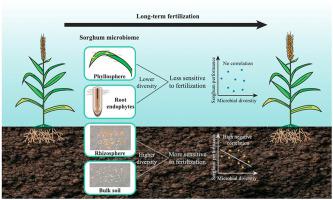Soil Biology and Biochemistry ( IF 9.8 ) Pub Date : 2020-12-15 , DOI: 10.1016/j.soilbio.2020.108113 Anqi Sun , Xiao-Yan Jiao , Qinglin Chen , Ai-Lian Wu , Yong Zheng , Yong-Xin Lin , Ji-Zheng He , Hang-Wei Hu

|
Crop harbors diverse microbial communities that profoundly influence host health and agricultural productivity. Crop habitat is a dynamic and heterogeneous environment, and thus crop microbiota may display spatial organization across different compartments. However, impacts of long-term fertilization, as a common agricultural practice, on the assembly of crop microbiota and their relationships with crop yield and quality remain largely unresolved. Here, we collected sorghum roots and leaves, and rhizosphere and bulk soils, from an eight-year field experiment with multiple fertilization regimes, and characterized sorghum-associated microbiomes by amplicon sequencing of bacterial 16S rRNA gene and fungal ITS region. Rhizosphere and bulk soils harbored significantly higher diversity of bacteria and fungi than phyllosphere and root endophytes, and the microbial community composition significantly differed across the four compartments. Fertilization significantly influenced the diversity and compositions of sorghum-associated microbial communities, but had more pronounced effects on rhizosphere and bulk soil microbiomes through altering the relative abundances of some major microbial biomarkers. Bacterial genera Lysobacter, Acidibacter, Steroidobacter, RB41, and Blastococcus, and fungal genera Fusarium and Guehomyces were the dominant microbial predictors of sorghum yield and protein content. Structural equation models revealed that fertilization had a positive and indirect effect on sorghum yield and protein content through influencing the microbial diversity in rhizosphere and bulk soils. We provide novel evidence that microbial communities in sorghum phyllosphere and root endosphere are more resistant than soil microbiota to long-term fertilization, and soil microbiota are important predictors of sorghum yield and protein content.
中文翻译:

作物根际和根内层的微生物群落比土壤微生物群落对施肥的抵抗力更高
作物拥有各种微生物群落,深刻影响寄主的健康状况和农业生产力。作物生境是一个动态且异质的环境,因此,作物微生物群可能在不同的区室中表现出空间组织。然而,作为一种常见的农业实践,长期施肥对农作物微生物群落的组装及其与农作物产量和质量的关系的影响尚未得到解决。在这里,我们通过八年的多次施肥田间试验,收集了高粱的根,叶,根际和土壤,并通过细菌16S rRNA基因和真菌ITS区域的扩增子测序来表征高粱相关的微生物。根际和散装土壤中细菌和真菌的多样性远高于叶际和根部内生菌,四个隔间的微生物群落组成明显不同。施肥显着影响了高粱相关微生物群落的多样性和组成,但通过改变一些主要微生物生物标志物的相对丰度,对根际和土壤微生物群落的影响更为明显。细菌属溶菌杆菌,酸性杆菌,类固醇杆菌,RB41和芽孢杆菌,以及镰刀菌属和Guehomyces属真菌是高粱产量和蛋白质含量的主要微生物预测因子。结构方程模型表明,施肥通过影响根际和土壤中的微生物多样性,对高粱的产量和蛋白质含量产生正向和间接的影响。我们提供了新的证据,表明高粱根际和根内层的微生物群落比土壤微生物群对长期施肥的抵抗力更强,而土壤微生物群是高粱产量和蛋白质含量的重要预测指标。











































 京公网安备 11010802027423号
京公网安备 11010802027423号